 Database
Database Mysql Tutorial
Mysql Tutorial How to design a flexible MySQL table structure to implement forum functions?
How to design a flexible MySQL table structure to implement forum functions?
How to design a flexible MySQL table structure to implement forum functions?
With the rapid development of the Internet, forums have become more and more popular as a communication platform. Designing a flexible MySQL table structure is an important step in realizing forum functionality. This article will introduce how to design a flexible MySQL table structure to implement forum functions and provide specific code examples.
1. User table (users)
The user table is an important part of the forum system and is used to store basic information of users. The following are examples of fields in the user table:
CREATE TABLE users (
id INT PRIMARY KEY AUTO_INCREMENT,
username VARCHAR(50) NOT NULL,
password VARCHAR(255) NOT NULL,
email VARCHAR(100) NOT NULL,
created_at TIMESTAMP DEFAULT CURRENT_TIMESTAMP
);2. Posts table (posts)
The posts table is used to store post information in the forum. The following are examples of fields in the post table:
CREATE TABLE posts (
id INT PRIMARY KEY AUTO_INCREMENT,
user_id INT NOT NULL,
title VARCHAR(255) NOT NULL,
content TEXT NOT NULL,
created_at TIMESTAMP DEFAULT CURRENT_TIMESTAMP,
FOREIGN KEY (user_id) REFERENCES users(id) ON DELETE CASCADE
);3. Comments table (comments)
The comments table is used to store the comment information of the post. The following are examples of fields in the comment table:
CREATE TABLE comments (
id INT PRIMARY KEY AUTO_INCREMENT,
user_id INT NOT NULL,
post_id INT NOT NULL,
content TEXT NOT NULL,
created_at TIMESTAMP DEFAULT CURRENT_TIMESTAMP,
FOREIGN KEY (user_id) REFERENCES users(id) ON DELETE CASCADE,
FOREIGN KEY (post_id) REFERENCES posts(id) ON DELETE CASCADE
);4. Categories table (categories)
The category table is used to store the classification information of posts in the forum. The following are examples of fields in the category table:
CREATE TABLE categories (
id INT PRIMARY KEY AUTO_INCREMENT,
name VARCHAR(100) NOT NULL,
created_at TIMESTAMP DEFAULT CURRENT_TIMESTAMP
);5. Post category association table (post_category)
The post category association table is used to associate the relationship between posts and categories. The following is an example of fields in the post category association table:
CREATE TABLE post_category (
id INT PRIMARY KEY AUTO_INCREMENT,
post_id INT NOT NULL,
category_id INT NOT NULL,
FOREIGN KEY (post_id) REFERENCES posts(id) ON DELETE CASCADE,
FOREIGN KEY (category_id) REFERENCES categories(id) ON DELETE CASCADE
);Through the above table structure design, we can implement a basic forum function. Users can register, log in, and post and comment. Posts can belong to one or more categories, and users can browse posts under different categories.
During development, we can optimize and expand the table structure according to specific needs. For example, you can add like tables, follow tables, etc. to achieve more functions. At the same time, you can also use indexing, partitioning and other technologies to improve query performance.
To sum up, designing a flexible MySQL table structure to implement forum functions is a complex process that requires full consideration of the relationships and business needs between different entities. Through reasonable table structure design, we can efficiently implement forum functions and facilitate subsequent expansion.
(Note: The above examples are only for illustration, the specific table structure design should be adjusted according to actual needs.)
The above is the detailed content of How to design a flexible MySQL table structure to implement forum functions?. For more information, please follow other related articles on the PHP Chinese website!
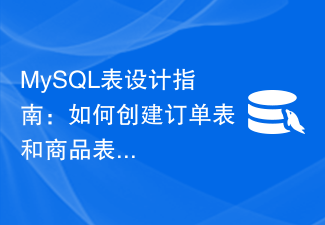 MySQL表设计指南:如何创建订单表和商品表Jul 02, 2023 pm 12:25 PM
MySQL表设计指南:如何创建订单表和商品表Jul 02, 2023 pm 12:25 PMMySQL表设计指南:如何创建订单表和商品表简介在数据库设计中,正确地创建表格是非常重要的。本文将重点介绍如何创建订单表和商品表,以提供一个指南供读者参考。同时,为了更好地理解,本文还会提供相关的代码示例。订单表设计订单表是用来存储订单信息的表。下面是一个简单的订单表设计示例:CREATETABLEorders(order_idINTPRIMARY
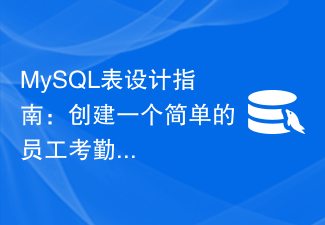 MySQL表设计指南:创建一个简单的员工考勤表Jul 01, 2023 pm 01:54 PM
MySQL表设计指南:创建一个简单的员工考勤表Jul 01, 2023 pm 01:54 PMMySQL表设计指南:创建一个简单的员工考勤表在企业管理中,员工的考勤管理是至关重要的一项任务。为了准确记录和统计员工的考勤情况,我们可以利用MySQL数据库来创建一个简单的员工考勤表。本篇文章将指导您如何设计和创建这个表,并提供相应的代码示例。首先,我们需要确定员工考勤表所需的字段。一般来说,员工考勤表至少需要包含以下字段:员工ID、日期、上班时间、下班时
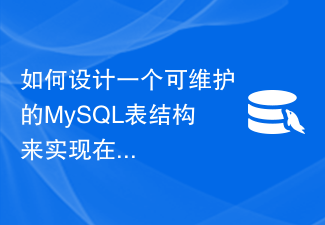 如何设计一个可维护的MySQL表结构来实现在线预订酒店功能?Oct 31, 2023 am 08:24 AM
如何设计一个可维护的MySQL表结构来实现在线预订酒店功能?Oct 31, 2023 am 08:24 AM如何设计一个可维护的MySQL表结构来实现在线预订酒店功能?在实现一个在线预订酒店的功能中,合理设计数据库表结构是非常重要的。一个良好的表结构可以提高系统的性能和可维护性。本文将介绍如何设计一个可维护的MySQL表结构来实现在线预订酒店功能,并提供具体的代码示例。酒店表(hotel)酒店表用于存储酒店的基本信息,例如酒店ID、酒店名称、地址、电话等。此外,可
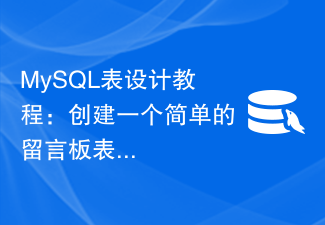 MySQL表设计教程:创建一个简单的留言板表Jul 02, 2023 pm 03:40 PM
MySQL表设计教程:创建一个简单的留言板表Jul 02, 2023 pm 03:40 PMMySQL表设计教程:创建一个简单的留言板表介绍在网站开发中,留言板是一个非常常见的功能,用于让用户在网站上发表评论、建立联系等。在设计留言板功能时,一个重要的步骤是创建适当的数据表来存储留言的信息。本文将教你如何使用MySQL来创建一个简单的留言板表。步骤一:创建数据库首先,我们需要创建一个数据库来存储留言板的数据。可以使用以下代码创建数据库:CREATE
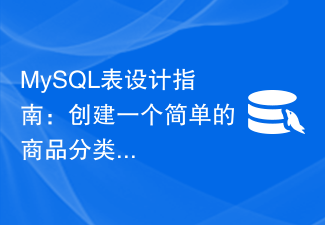 MySQL表设计指南:创建一个简单的商品分类表Aug 03, 2023 pm 02:28 PM
MySQL表设计指南:创建一个简单的商品分类表Aug 03, 2023 pm 02:28 PMMySQL表设计指南:创建一个简单的商品分类表在数据库设计中,良好的表设计是非常重要的,它直接影响到数据的存储和查询效率。本文将介绍如何创建一个简单的商品分类表,并提供相应的代码示例。一、表结构设计商品分类表主要包括以下字段:分类ID、分类名称、父分类ID。其中,分类ID是表的主键,分类名称存储分类的名称,父分类ID用于表示当前分类的父级分类。下面是商品分类
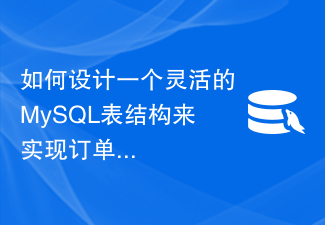 如何设计一个灵活的MySQL表结构来实现订单管理功能?Oct 31, 2023 am 09:48 AM
如何设计一个灵活的MySQL表结构来实现订单管理功能?Oct 31, 2023 am 09:48 AM如何设计一个灵活的MySQL表结构来实现订单管理功能?订单管理是许多企业和电商网站的核心功能之一。为了实现这个功能,一个重要的步骤是设计一个灵活的MySQL表结构来存储订单相关的数据。一个好的表结构设计能够提高系统的性能和可维护性。本文将介绍如何设计一个灵活的MySQL表结构,并提供具体的代码示例来辅助理解。订单表(Order)订单表是存储订单信息的主要表。
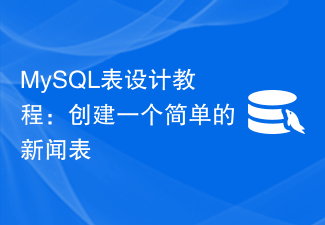 MySQL表设计教程:创建一个简单的新闻表Jul 02, 2023 pm 03:08 PM
MySQL表设计教程:创建一个简单的新闻表Jul 02, 2023 pm 03:08 PMMySQL表设计教程:创建一个简单的新闻表在开发网站或应用程序时,新闻表是一个常见的数据库表之一。它用于存储和管理新闻文章的相关信息,如标题、内容、作者、发布日期等。本文将介绍如何使用MySQL创建一个简单的新闻表,并给出相应的代码示例。首先,我们需要创建一个数据库来存储新闻表。可以使用以下代码来创建一个名为"news_db"的数据库:CREATEDATA
 如何设计MySQL表结构来管理仓库库存?Oct 31, 2023 am 09:04 AM
如何设计MySQL表结构来管理仓库库存?Oct 31, 2023 am 09:04 AM如何设计MySQL表结构来管理仓库库存随着物流行业的发展,仓库库存管理变得越来越重要。在仓库中,准确记录和管理库存可以帮助企业提高运营效率和客户满意度。MySQL作为一种广泛应用的关系型数据库管理系统,可以帮助我们有效地管理仓库库存。本文将探讨如何设计MySQL表结构来管理仓库库存,并提供具体的代码示例。仓库表(Warehouse)仓库表用于存储仓库的基本信


Hot AI Tools

Undresser.AI Undress
AI-powered app for creating realistic nude photos

AI Clothes Remover
Online AI tool for removing clothes from photos.

Undress AI Tool
Undress images for free

Clothoff.io
AI clothes remover

AI Hentai Generator
Generate AI Hentai for free.

Hot Article

Hot Tools

DVWA
Damn Vulnerable Web App (DVWA) is a PHP/MySQL web application that is very vulnerable. Its main goals are to be an aid for security professionals to test their skills and tools in a legal environment, to help web developers better understand the process of securing web applications, and to help teachers/students teach/learn in a classroom environment Web application security. The goal of DVWA is to practice some of the most common web vulnerabilities through a simple and straightforward interface, with varying degrees of difficulty. Please note that this software

EditPlus Chinese cracked version
Small size, syntax highlighting, does not support code prompt function

Dreamweaver CS6
Visual web development tools

SublimeText3 Chinese version
Chinese version, very easy to use

MantisBT
Mantis is an easy-to-deploy web-based defect tracking tool designed to aid in product defect tracking. It requires PHP, MySQL and a web server. Check out our demo and hosting services.





